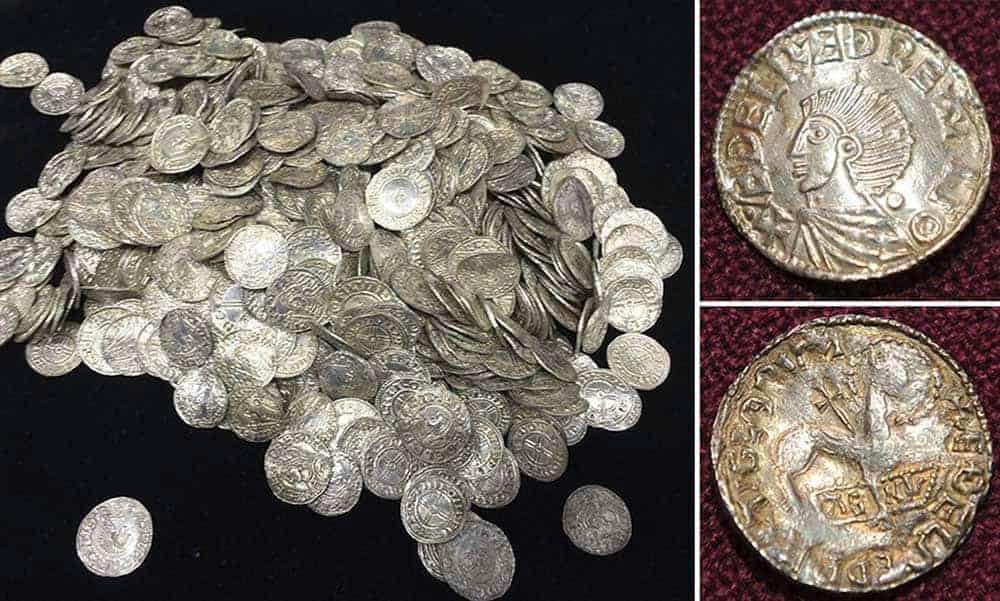In a groundbreaking archaeological discovery that has captivated historians and numismatists worldwide, a remarkable collection of Anglo-Saxon coins has been unearthed in Lenborough, Buckinghamshire. This extraordinary find, hailed as one of the most significant of its kind in modern history, offers an unparalleled glimpse into the economic, political, and religious life of medieval England.
On December 21, 2023, what began as an ordinary metal-detecting expedition turned into an extraordinary event. Paul Coleman, an experienced metal detectorist, initially mistook his find for a manhole cover buried beneath the soil. However, his determination soon revealed an astonishing treasure: two distinct caches of silver pennies, amounting to a staggering total of 5,248 coins. These coins were buried approximately 15 years apart, a detail that has sparked great interest among scholars.

The coins primarily date back to the reigns of two prominent Anglo-Saxon kings: Ethelred the Unready (978–1016) and Canute (1016–1035). Among them is a rare and unique “Agnus Dei” coin, featuring an unusual design of a lamb and flag instead of the more common dove of peace. This minting error has garnered significant attention from experts, who regard it as a rare glimpse into the complexities of medieval minting practices.
The scale of this discovery is unprecedented. Brett Thorn, a specialist from the Buckinghamshire County Museum, noted that the last comparable find occurred in the 1840s, when over 7,000 silver coins were uncovered. What sets the Lenborough hoard apart is the exceptional state of preservation of many coins, making this discovery a treasure not just in quantity but also in quality.
The estimated monetary value of the hoard is equally remarkable. While awaiting official valuation, early estimates suggest the collection could exceed £1 million. Under current treasure trove laws in the United Kingdom, Paul Coleman and the landowner will share any proceeds from future sales or museum acquisitions. This legal framework ensures that significant archaeological finds benefit not only their discoverers but also the broader public through preservation and display.
Beyond its monetary worth, the Lenborough hoard holds immense historical significance. The coins were minted in over 40 different locations across the Anglo-Saxon kingdom, providing a unique snapshot of the administrative and economic network of the time. The presence of the rare “Agnus Dei” coin adds a religious dimension to the hoard, shedding light on the evolving interplay between politics and faith during this period. Scholars believe this coin’s distinctive imagery may reflect regional influences or even specific events of the era, making it an invaluable artifact for understanding the cultural and political context of early medieval England.
Currently housed at the British Museum for analysis and preservation, the collection has already begun to yield valuable insights into Anglo-Saxon society. Researchers are meticulously studying the coins to determine their origins, circulation patterns, and the circumstances surrounding their burial. This analysis will help unravel the story of why such a large collection was amassed and hidden, offering potential clues about the political and economic instability of the time.
The Buckinghamshire County Museum has expressed a strong desire to acquire the hoard for permanent display in its original county. This effort is contingent upon successful fundraising to meet the required percentage of the hoard’s value. A local display would not only honor the discovery’s historical context but also make the hoard accessible to the community where it was found, ensuring its legacy as a source of education and inspiration.
This discovery underscores the critical role amateur archaeologists and metal detectorists play in uncovering and preserving history. Paul Coleman’s find is a testament to the potential for individuals to contribute meaningfully to our understanding of the past. His discovery, handled with care and promptly reported to authorities, has allowed experts to study and preserve this treasure for future generations.
The Lenborough hoard also highlights the enduring allure of England’s medieval history. Its significance extends beyond its intrinsic and monetary value, serving as a tangible connection to a pivotal era in the nation’s development. By examining these coins, historians gain a deeper understanding of trade networks, currency systems, and the socio-political landscape of Anglo-Saxon England.
As the analysis continues and plans for public display move forward, the Lenborough hoard promises to become a centerpiece of medieval studies. It serves as a vivid reminder of the rich heritage that lies beneath the surface of modern landscapes, waiting to be discovered. For history enthusiasts, numismatists, and the general public alike, this extraordinary find offers a rare opportunity to connect with the past in a meaningful way.
The legacy of the Lenborough hoard is multifaceted. It not only enhances our historical understanding but also inspires future generations to appreciate and protect our shared heritage. As efforts to preserve and display the collection advance, this discovery will undoubtedly remain a symbol of the enduring importance of archaeology and the stories it unearths.
This remarkable find will continue to captivate and educate, offering a window into a time when England was a patchwork of kingdoms, united by a shared currency yet divided by power struggles. The Lenborough hoard stands as a tribute to the richness of the Anglo-Saxon period and a reminder of the countless treasures still waiting to be uncovered, each with its own story to tell.





